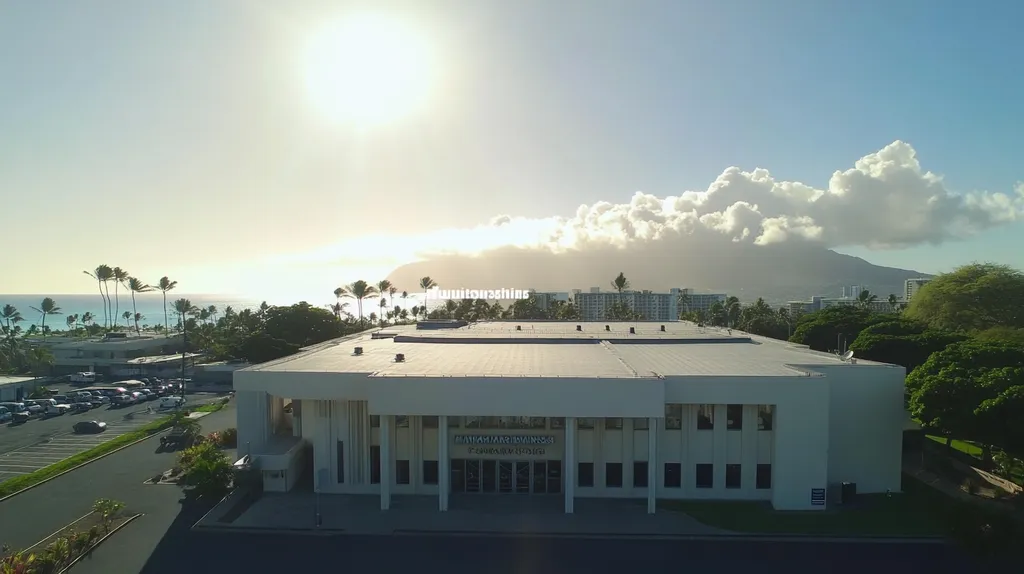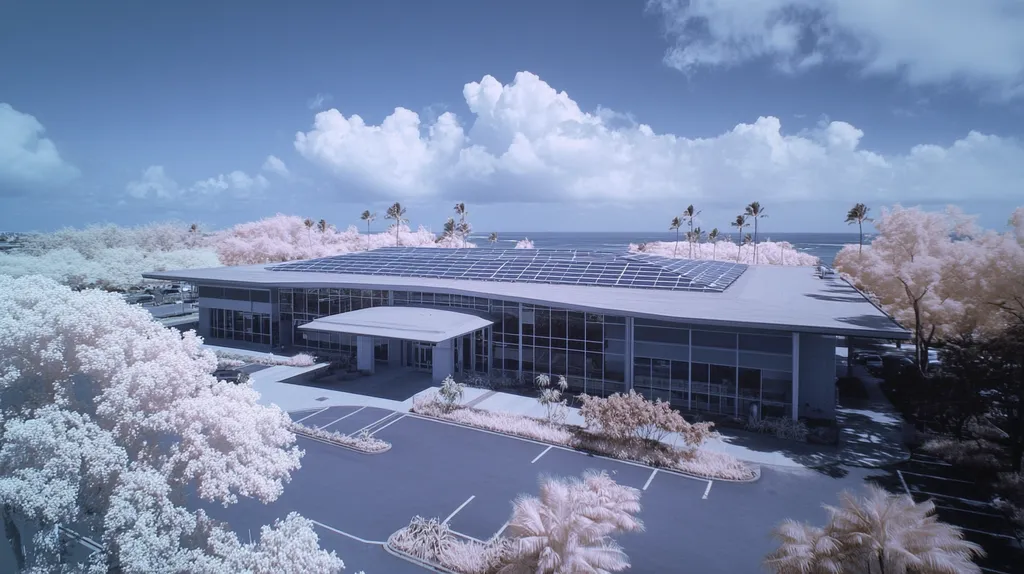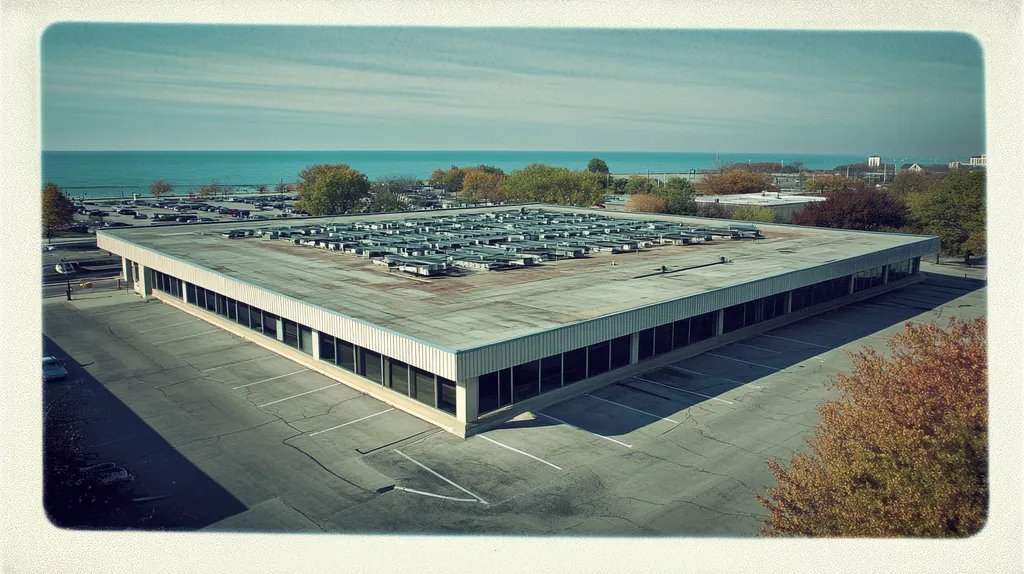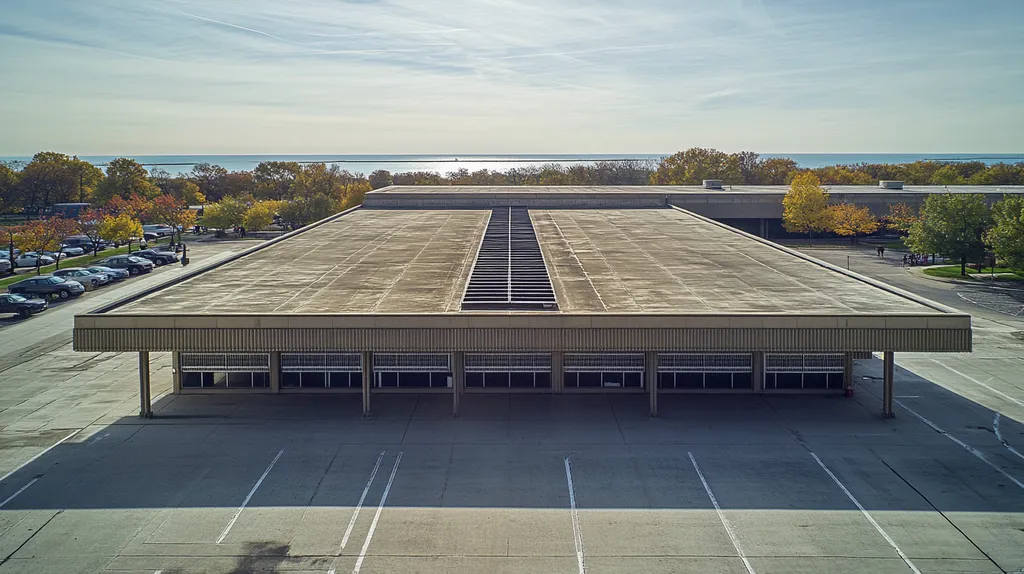Tree branches are silently waging war on industrial roofs across America, with damage from falling limbs and debris costing facility owners over $125 million annually in repairs.
From punctured membranes to compromised structural integrity, these seemingly innocent overhanging branches pose a serious threat to every component of commercial roofing systems.
Understanding how different roofing materials interact with tree hazards, implementing proper maintenance protocols, and developing strategic preventive measures can mean the difference between minor repairs and catastrophic failures that shut down operations.
SECTION 1: FUNDAMENTAL CONCEPTS
Tree branches can quietly wreak havoc on industrial roofing materials, leading to damage that might cost industries millions in repairs every year. Understanding the types of damage that can occur, the influence of wind and debris, and how different roofing materials respond to these hazards is essential for property owners and facility managers. This knowledge can ultimately protect their investments and prolong the lifespan of their roofs.
Types of Tree-Related Roof Damage
Tree branches can inflict a range of damages on industrial roofs. The most prevalent issues include punctures, abrasions, and debris buildup. Punctures often result from heavy branches that fall, potentially jeopardizing the roofing membrane’s integrity.
Abrasions may arise when overhanging branches make constant contact, wearing down vital protective layers. Furthermore, fallen leaves and branches can clog drainage systems. This blockage can result in water pooling, which may seep into the roofing material and create leaks that lead to extensive internal damage.
Large branches also have the potential to cause structural harm, compromising the entire roof framework. Regular inspections and maintenance of nearby trees are therefore crucial for extending the lifespan of commercial roofs.
Impact of Wind and Debris on Roofs
Wind plays a significant role in how tree branches impact roofing materials. During storms, gusts can snap branches and send debris flying, increasing the risk of damage to roofs. Wind-driven debris can penetrate even the toughest roofing systems, resulting in unexpected breaks and tears.
Moreover, wind can amplify the movement of branches, causing them to scrape against the roof’s surface. This repeated abrasion can weaken roofing materials, leading to premature failures or unnoticed leaks that can spiral into costly repairs.
For facility managers, it’s vital to factor in wind patterns and local weather when assessing tree placement. Investing time in wind assessments can be essential for preventing future repairs and safeguarding overall building integrity.
Roof Material Susceptibility to Tree Branches
Not all roofing materials react equally to tree branch impacts. For example, low-slope roofing membranes like TPO or EPDM are more prone to punctures than metal roofs, which tend to withstand physical impacts better.
Asphalt shingles are also vulnerable to abrasive damage over time due to contact with tree branches. This wear can lead to granule loss, diminishing the roof’s ability to shed water effectively.
Understanding these material differences is crucial for property owners during their roofing decisions. Choosing more resilient options can ultimately result in significant savings on repairs and replacements.
Regular inspections and prompt maintenance are also recommended to ensure that the roofing system performs at its best, especially in tree-rich environments. (source: All That Roofing)
SECTION 2: SYSTEM COMPONENTS
Tree branches pose a serious threat to industrial roofing systems, leading to expensive repairs and time-consuming downtimes. Falling branches can puncture roofing membranes, disrupt insulation, and may even compromise the entire roof structure. For property owners and facility managers, grasping the implications of these elements on roofing materials is essential for making smart maintenance choices and safeguarding against financial setbacks.
Roofing Materials and Their Durability
The choice of roofing material is pivotal in determining how well a roof can fend off damage from tree branches. Materials like EPDM, TPO, and PVC are known for their durability, yet they can still suffer from sharp or heavy branches. For instance, a heavy limb can easily puncture an EPDM membrane, resulting in leaks that could spiral into costly structural repairs.
On the other hand, robust materials like metal roofing generally provide superior resistance to impact. Still, metal roofs can also experience dents and scratches from frequent contact with tree branches. Recognizing the specific characteristics of each material allows facility managers to choose the optimal roofing solution tailored to their building’s unique needs.
Additionally, the age and condition of roofing materials must not be overlooked. Older systems may harbor weakened sections that become especially vulnerable to branch interference. Consistent inspections are key to identifying these weaknesses before they escalate into major issues.
Ultimately, selecting roofing materials with the appropriate durability ratings can significantly reduce the risks posed by natural elements, including tree branches, extending the roof’s longevity and overall effectiveness.
Effects on Roofing Layers and Underlayment
Tree branches can dramatically impact the integrity of various layers within an industrial roofing system. The underlayment, a vital barrier against water intrusion, can be damaged or displaced when branches scrape against the surface. This creates weak spots that are ripe for leaks.
In complex, multi-layered roofing systems, damage to one layer can have a domino effect, leading to widespread issues. If branches manage to breach the outer layer, they can threaten the underlayment and insulation below, promoting moisture buildup that can foster mold, resulting in health risks and costly remediation efforts.
These damages are often stealthy, leaving facility managers oblivious to problems lurking beneath the surface. Many hidden issues can only be uncovered through thorough inspections, further stressing the importance of proactive maintenance and tree management to mitigate severe long-term consequences.
In summary, a solid understanding of how tree branches can compromise roofing layers is crucial for implementing strategies that protect the entire roofing system.
Vulnerability of Roof Seams and Edges
Roof seams and edges are particularly susceptible to damage from tree branches. The seams, where different roofing materials converge, are vital for maintaining a watertight seal. A hefty branch can easily disrupt this delicate connection, leading to leaks and escalating repair demands.
Moreover, the edges of the roof can endure abrasive wear and impact, especially where protective finishes are worn down from continuous branch contact. Without regular monitoring, these edge areas can become hotspots for deterioration.
Additionally, branches can create unintended water pathways into the roof system, making it even harder to maintain a proper watertight barrier. Such infiltration can lead to significant internal damage, especially during harsh weather, where water can freeze and expand.
Regular inspection and timely attention to seams and edges, especially those near trees, are essential. Facility managers should prioritize proactive measures, such as pruning and maintaining neighboring trees, to safeguard the roofing system’s structural integrity.
SECTION 3: IMPLEMENTATION METHODS
The threat posed by tree branches to industrial rooftops is a pressing reality that can generate severe structural damage and high repair bills. It’s no surprise that inadequate tree maintenance can result in costs soaring beyond $10,000 per incident. Therefore, proactive measures like tree trimming, investing in resilient roofing systems, and reinforcing roof structures are essential steps to protect this key investment. By implementing these strategies, property owners and facility managers can significantly reduce risks and extend the life of their roofs.
Preventive Tree Trimming and Maintenance
Preventive tree trimming is crucial to mitigating risks from industrial roofing damage. Regularly scheduled maintenance keeps branches well away from rooftops, minimizing potential threats during storms or high winds. Property owners should engage professional arborists who can assess tree health and carry out essential pruning.
Beyond just trimming, nourishing trees through proper watering and pest management can prevent dead limbs from falling and becoming hazards. Remember, a thriving tree is much less likely to shed branches that could cause harm to the roof below. This proactive approach plays a direct role in enhancing both roofing longevity and integrity.
Additionally, setting up a routine to evaluate tree proximity to roofs should be woven into an ongoing maintenance strategy. That vigilance means addressing issues before they escalate into expensive repairs. Investing in tree health pays off in the long run, and it’s far better than dealing with the fallout of neglect.
In summary, implementing an effective tree management strategy is vital. Property owners should recognize the link between tree health and roof durability as integral to a comprehensive maintenance plan.
Installing Wind-Resistant Roofing Systems
Upgrading to wind-resistant roofing systems is a smart strategy for facilities situated near trees. These specialized roofing materials are engineered to handle high winds and falling branches better than standard options. Choosing roofing rated for high-wind regions, per industry guidelines, enhances overall protection.
For instance, roofing systems made with reinforced membranes or metal can better withstand impacts from tree branches. These materials not only resist strong gusts but also minimize damage if they are struck by debris. Such an investment adds significant value to properties by enhancing roof durability and resilience.
Facility owners should conduct roofing audits to determine if current materials adequately suit their environment. Teaming up with roofing professionals to explore new technologies can illuminate the best solutions available for tackling risks from tree branches.
Ultimately, adopting wind-resistant roofing systems is a proactive measure that helps secure both the roof and the investment it represents.
Reinforcing Roof Structures Against Tree Falls
Reinforcing roof structures is another essential strategy to guard against the hazards posed by falling branches. This involves evaluating and strengthening support systems to ensure they can absorb impacts without compromising the roof’s integrity. A structural engineer’s assessment is often required to pinpoint suitable reinforcements.
Introducing structural beams or trusses bolsters a roof’s ability to withstand impacts from branches. Such enhancements not only increase overall durability but can also be seamlessly integrated during routine maintenance or roof replacement projects, leading to long-term savings from reduced repair needs.
Additionally, property managers should consider adding protective barriers around their properties, such as fences or implementing vegetation management plans. These extra measures can help steer falling debris away from critical roofing areas.
In summary, reinforcing roof structures against tree falls is a crucial investment that not only ensures safety but also contributes to the longevity of roofing systems.
SECTION 4: MAINTENANCE REQUIREMENTS
Neglecting the maintenance of industrial roofing, particularly in tree-laden areas, is like leaving a door wide open during a storm—it invites disaster. Regular inspections are not just recommended; they are essential for safeguarding roofs against damage that can cost property owners a small fortune. Studies show that untreated roofs can suffer a staggering 25% reduction in lifespan due to environmental overstresses, including pesky tree debris. This section highlights crucial maintenance practices that are your best defense in extending the life and functionality of your roofing investment.
Regular Roof Inspections for Tree Damage
Regular inspections are crucial for catching tree-induced damage before it spirals out of control. Property owners should aim for a thorough roof check at least twice a year, and especially after severe weather events. Inspectors should be on the lookout for signs of wear and tear, such as punctures in the roofing membrane or misaligned materials.
It’s important to pay extra attention to areas near trees, where shade can facilitate moisture accumulation and speed up deterioration. Catching issues early means small fixes instead of major repairs down the line—saving thousands in potential costs.
Involving trained roofing professionals in inspections guarantees a meticulous assessment of the roof’s condition. They can pinpoint how tree branches might threaten roofing integrity and provide tailored advice. Keeping a detailed log of inspection findings not only helps track maintenance over time but can also be invaluable for future evaluations.
Ultimately, regular inspections are a smart, proactive approach that pays off in significant potential savings and peace of mind. Skipping these checks can lead to steep financial and structural consequences, underscoring the need for vigilant maintenance.
Clearing Debris and Branches from Roofs
Keeping roofs clear of branches and debris is vital for effective drainage and preventing biological growth. Piles of leaves and twigs don’t just look messy; they create moisture traps that can lead to mold and mildew that compromise roofing materials. Property owners should establish a dependable debris removal routine, especially during the fall when leaves are plentiful.
Safety is key when it comes to debris clearance. Workers must wear appropriate safety gear and follow fall protection practices when accessing rooftops. A clean roof surface is not only important for performance but also protects the underlying structures from unseen damage.
Ignoring debris can lead to clogged drains, resulting in water pooling that brings added risk of leaks. Therefore, keeping the roof clean is directly linked to the longevity of roofing materials and their performance.
Addressing Moisture Retention Issues
Moisture retention is a serious problem when branches and debris pile up on roofs. Standing water not only encourages mold growth but also can lead to structural damage as it seeps into insulation and the roof deck. When protective roof coatings erode, moisture accumulates, paving the way for leaks and additional issues.
Regular inspections can help identify areas susceptible to moisture buildup. Low-slope roofs, in particular, are prone to this issue, so proactive measures are essential. Implementing effective drainage solutions, like scuppers and gutters, ensures that water flows properly, keeping it off the roof surface.
In some instances, a high-quality waterproof membrane might be necessary to tackle long-term moisture concerns. Investing in robust materials now can save headaches later by preventing moisture infiltration and extending the roof’s lifespan.
Managing moisture effectively is not just essential for the roof itself; it safeguards the entire facility. A well-maintained roof can minimize operational disruptions and create a safe working atmosphere. Ignoring moisture issues can lead to costly repairs and impact property value significantly.
SECTION 5: PERFORMANCE METRICS
The looming presence of overhanging tree branches is more than just a nuisance; it poses a significant threat to the integrity of industrial roofing systems. In fact, nearly 30% of damage to commercial roofs stems from tree-related incidents, which can lead to costly repairs and unsafe conditions for tenants. For property owners and facility managers, understanding how to assess damage, evaluate roof integrity after storms, and measure the cost-effectiveness of repairs is crucial for ensuring long-term operational safety and financial prudence. Let’s dive into these vital areas to equip building stakeholders with the necessary tools for effective roof management.
Assessing Damage from Tree Branches
Understanding the extent of damage caused by tree branches is critical for any property owner. Frequently, indicators of roof issues manifest as leaks or noticeable dents that may appear long after the initial impact, underscoring the importance of prompt assessments.
Property managers should conduct regular inspections, particularly during fall and spring when branches are more likely to break. Leveraging technology such as drones or advanced imaging can significantly enhance these evaluations, providing a thorough overview while prioritizing worker safety.
Best practices include looking for punctures, loose granules on roofing membranes, and debris accumulation in gutters, all of which can signal potential issues. Not every damaged area is easily identifiable, especially on low-slope roofs, so infrared thermography can help uncover hidden problems.
Ultimately, timely assessments facilitate swift action, reducing the risk of further degradation and preventing costly repairs down the road.
Evaluating Roof Integrity Post-Storm
Severe storms can intensify the risks posed by tree branches on roofing materials. Following such weather events, facility managers must perform exhaustive inspections to determine the roof’s structural integrity. Roofs that suffer from hidden damage can pose significant hazards if left unaddressed.
Common evaluation practices include checking for signs of water intrusion, which can be hidden within insulation or decking. A comprehensive inspection must encompass not only the surface but also any penetrations or seams vulnerable to damage.
Visual signs like blistering or sagging can reveal underlying issues requiring immediate attention. Post-storm drone inspections can facilitate these detailed examinations, eliminating the need for hazardous rooftop access.
Proactive assessments not only safeguard asset value but also ensure the safety of building occupants, contributing to effective risk management strategies.
Measuring Cost-Effectiveness of Repairs
Finding the optimal strategy for roofing repairs involves a careful analysis of both immediate costs and long-term implications. Effective cost assessments should take into consideration the nature of the tree-related damage, the existing roofing material quality, and the overall maintenance budget.
Investing in high-quality repairs may come with a higher initial price tag, but it often leads to greater durability and fewer future issues. In contrast, quick fixes may result in escalating expenses over time due to recurring maintenance or more extensive repairs eventually becoming necessary.
Property managers should also factor in potential productivity losses during repair timelines, as this adds to the overall cost of damage. Collaborating with a qualified roofing contractor can elucidate the most cost-effective solutions, weighing both immediate and long-term financial impacts.
By strategically planning repair investments, property owners and facility managers can enhance the integrity of their roofs while maintaining fiscal responsibility.
SECTION 5: PERFORMANCE METRICS
The looming threat posed by overhanging tree branches is a serious issue for industrial roofing systems. Alarmingly, nearly 30% of commercial roof damage arises from tree-related incidents, leading to costly repairs and potential safety hazards for tenants. For property owners and facility managers, it’s imperative to know how to assess damage, evaluate roof integrity post-storm, and understand the cost-effectiveness of repairs. This knowledge not only safeguards investments but also ensures operational safety. Let’s explore these critical areas to empower building stakeholders with effective roof management strategies.
Assessing Damage from Tree Branches
Understanding the damage caused by tree branches is essential for property owners aiming to maintain a sound roof. Initial signs of trouble often manifest as leaks or unsightly dents that might appear long after a branch incident. This makes timely evaluations all the more crucial.
Property managers should prioritize regular inspections, particularly in the fall and spring when vulnerability to branch breakage is heightened. Utilizing aerial technology like drones can make these evaluations safer and more comprehensive, allowing for a detailed view from above without risking worker safety.
Best practices include searching for punctures, loose granules, and any debris piling up in gutters, all of which can hint at underlying damage. Since low-slope roofs can hide issues, infrared thermography can be a game-changer in exposing hidden problems.
Ultimately, timely assessments enable quick corrective actions, reducing the likelihood of severe degradation and expensive repairs down the line.
Evaluating Roof Integrity Post-Storm
Severe storms can significantly heighten the risks from tree branches, turning a mere nuisance into a potential disaster for roofing materials. After such events, facility managers must carry out thorough inspections to ensure no aspects of structural integrity are compromised. Undetected damage can pose serious risks if left unattended.
Common evaluation techniques involve checking for signs of water intrusion, often concealed within insulation or roofing layers. The inspection should cover not just the exterior, but also any critical penetrations or seams that may have been impacted.
Visual warnings like blistering or sagging can be indicators of deeper issues needing immediate remediation. Employing drones for thorough post-storm checks can facilitate safe and efficient examinations without the need for risky rooftop access.
Proactive assessments protect the value of assets and ensure the safety of building occupants, contributing to a comprehensive risk management approach.
Measuring Cost-Effectiveness of Repairs
Choosing the best repair strategy for roofing involves analyzing both short-term costs and long-term implications. A thorough cost analysis should weigh the specific nature of tree-related damage, current roofing materials, and maintenance budgets in play.
Investing in high-quality repairs may seem expensive initially but typically leads to greater durability and fewer issues in the future. On the flip side, quick fixes might result in spiraling costs due to ongoing maintenance or, worse, the need for extensive repairs down the line.
Further complicating the situation is the potential for productivity losses during repair periods, which adds another layer to the overall expense. Consulting with a qualified roofing contractor can clarify the most cost-effective solutions, taking into account both immediate and future financial implications.
By planning repair investments with a strategic approach, property owners and facility managers can bolster the integrity of their roofing assets while maintaining financial prudence.
The Bottom Line
With tree-related damage costing industrial facilities over $125 million annually, the stakes couldn’t be higher for property owners and facility managers.
Regular inspections, proper tree maintenance, and strategic material choices can mean the difference between minor repairs and catastrophic roof failures that shut down operations.
The key is implementing a comprehensive approach that includes preventive tree trimming, wind-resistant roofing systems, and reinforced structural elements.
By following industry best practices for assessment, maintenance, and repair, facility managers can extend roof lifespans by 15-20 years while protecting their substantial roofing investments.
The time to act is now – before the next storm turns those overhanging branches into costly liabilities.
FREQUENTLY ASKED QUESTIONS
Q. What types of damage can branches cause to a commercial roof?
A. Tree branches can create various issues such as punctures, abrasions, and debris buildup. Punctures occur from heavy falling branches, compromising the roofing membrane’s integrity. Abrasions happen when overhanging limbs scrape against the surface, accelerating wear and potential leaks.
Q. How do tree branches disrupt an industrial roof’s structure?
A. Falling branches can puncture roofing membranes, damage insulation, and destabilize the entire structure. They create weak points that allow moisture to penetrate, leading to mold and further structural degradation. Understanding these risks aids in making informed maintenance decisions.
Q. What materials are most vulnerable to branch damage on an industrial roof?
A. Low-slope roofing materials like EPDM and TPO are more prone to punctures, while asphalt shingles are vulnerable to abrasions. Metal roofs tend to resist impacts better but can still suffer from scratches. Selecting appropriate materials can mitigate risks from tree branches.
Q. Why is regular roof inspection important for commercial roofs near trees?
A. Regular inspections help catch tree-related damage early, preventing hefty repair bills later on. Inspectors can identify issues like punctures and debris buildup, especially after storms. Proactive assessments allow property owners to address problems before they escalate, ultimately saving money.
Q. What preventive measures can I take to protect my industrial roof?
A. Regular tree trimming and maintenance are crucial for minimizing risks to your roof. Investing in wind-resistant roofing systems can also bolster protection. Additionally, reinforcing roof structures and establishing maintenance routines can greatly extend the life of your investment.
Q. How can I assess roof damage after a storm?
A. After a storm, inspect for water intrusion and check the roof’s surface for sagging or blistering. Utilize drones to safely evaluate hard-to-reach areas. Documenting visible signs of damage ensures timely repairs and protects long-term asset value.
Q. What should I do about moisture issues on my industrial roof?
A. Address moisture issues by implementing effective drainage solutions like gutters and scuppers. Routine inspections can identify areas prone to moisture buildup. Upgrading to a high-quality waterproof membrane can also protect against leaks and extend the roof’s lifespan significantly.











